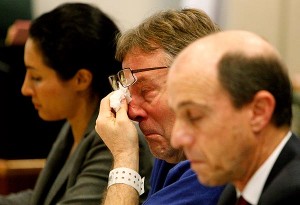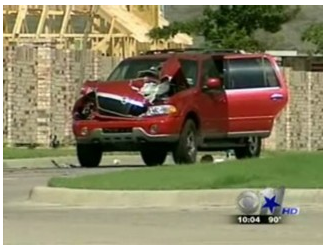COMPARING SENTENCES – THEY DON’T ALWAYS ADD UP
What a difference a state makes – or so it seems.
CALIFORNIA ROAD RAGE CASE – FIVE YEAR SENTENCE
In California, Dr. Christopher Thompson was convicted in a well reported “road rage” incident. Testimony in the case included stories from several cyclists who were involved in road rage incidents with Dr. Thompson – the key event was not his only reported transgression! It took a couple before the prosecution decided to go after him.
The paper trail of prior reports was helpful in getting the prosecutor, and the court, to believe that an Emergency Room physician could actually be so cold-hearted towards human life. The testimony from those on the scene that Dr. Thompson said he “wanted to teach them a lesson” was chilling. You can read Bob Mionske’s take on the case here.
As shown in this LA Times pic, Dr. Thompson was crying in court during the sentencing and was led out of the courtroom in handcuffs the other day after learning that the judge gave him a FIVE YEAR sentence for causing the road rage incident. You can read the whole LA Time story here.
If only justice worked as well in every case.
TEXAS CASE – TWO CYCLISTS KILLED – TWO YEAR SENTENCE
On December 17, 2009, “justice” was handed down in the Kenneth Bain case out of Texas. Mr. Bain had allegedly been driving home in his Lincoln Navigator from a bachelor party at 8:15 am, after ingesting both alcohol and pot, when he ran into, and killed, two cyclists.
The two cyclists, Meredith Hatch and Mike Alfaro, were members of a local cycling group and were training for an event when they were struck from behind and killed. The photo of the huge Lincoln Navigator, from a local CBS television station’s website, shows the damage to the front of vehicle.
Mr. Bain was sentenced on December 17. His sentence was TWO years in prison with an additional 10 years of probation.
The families of the two cyclists, and local cycling advocates, were shocked and outraged. You can read about it here.
How do you get such different results? A guy in a road rage case who hurts, but does not kill, two cyclists gets five years. A guy who ingested pot and alcohol at a party and then kills two cyclists by striking them from behind gets two years?
I wish I had an answer. There are usually personal, legal or political factors that come into play in these cases, unfortunately.
In the the Texas case there were reports that the BAC for the driver was not over the limit and that there was some reluctance of the family of one victim to put the children on the witness stand. There were additional reports speculating that Mr. Bain’s lawyer, a sitting Texas State Senator, or Mr. Bain’s family/money may have played a role. Perhaps the prosecution was worried about some factual or legal issues and didn’t want to take a chance of this one getting away. We’ll never know.
In the California case, you had clear evidence that the doc was actually INTENDING to do some harm. There was testimony that the doc said he wanted to “teach them a lesson.”
In the Texas case, the driver was stupid, careless and maybe feeling the effects of a long night of partying, but there was no evidence of ill intent. There was no evidence that he intended to hit the riders. That would have led to murder charges.
That distinction – what the judge or jury believe is inside the MIND of the wrongdoer – is a typical dividing line for sentencing. Intentional and malicious actions are usually punished more severely than careless or stupid actions.
Indeed, in Indiana a few years ago FIVE motorcyclists were killed [and many suffered life changing injuries] in 3 separate accidents on the same day, all occurring within an hour of so of each other in broad daylight. In each case a relatively young motorist did something stupid and careless to cause the crash. None of the motorists were drunk or high – just careless. None of the motorcycle operators did anything wrong. The prosecutor, in each case, refused to press criminal charges saying “We don’t prosecute negligence in Indiana.”
When alcohol or drugs are involved, though, many states crank up the sentencing, even for “careless” and non-intentional actions. In the Texas case, while there was evidence of both, there may not have been enough evidence to show “impairment.” Compare these two cases to the two Ohio cases discussed below…





